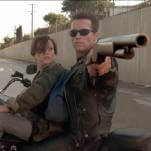Almost every time someone praises a prestige cable drama, the word “complex” appears in an admiring context. To rise above mere television and earn the right to be considered art, a serialized show must have something like the labyrinthine moral landscape of The Sopranos, the multiple plotlines of Game of Thrones, the intricate pursuits of The Wire, or the mutating social-historical milieu of Mad Men. The mandate for complexity, arguably, contributed to the struggles of aspirants to the prestige club like Kurt Sutter (Sons of Anarchy) and Nic Pizzolato (True Detective).
I can only think of two serialized dramas that make a deliberate point of bucking this trend. One is FX’s sublime Fargo—but only in its first season. The other is Better Call Saul. And as season 2 hits its stride, Gilligan and Gould are doubling down on their radical narrative strategy of simplicity. Characters pause before they make decisions. The small and finite set of contexts and causes impinging on them is clearly delineated. Consequences proceed directly from actions. And at the end of every episode, Jimmy and Mike, the protagonists of the only two plotlines, have moved a few spaces along a game board whose finish line is already set, and we know exactly what to anticipate the next time we see them.
But simple doesn’t mean simplistic. Because the plots are stripped down and moved forward step by step, we strategize alongside the characters. Because their decisions are given a generous cushion of narrative space, we hang suspended with them in their pivotal moments. Because the stakes are clear, we feel the existential weight shift from the anxiety of a free agent to the nausea of a condemned victim.
Just look at how “Amarillo” ends. Jimmy goes back to an oblivious Kim and a movie about submarines being crushed under pressure, knowing now that his decision to bypass his boss won’t be excused on the grounds that he made it work. Over the course of the hour, here’s where he has been:
- the ragged fringes of respectable lawyering (with his stunt on the bus);
- an ostentatious pledge to avoid even the appearance of solicitation (provoked by the withering disdain of his brother);
- a new height of achievement in the creative work of persuasion that he lives for (the commercial);
- the momentous choice not to submit his masterstroke to another’s approval, instead rolling the dice first that he will succeed, and second that success will cover his sins;
- triumph as his first gamble pays off;
- and finally, dread of the coming morning, when the bill comes due for the second one.
Consider how much psychological ground that covers, and how spare and spacious are the scenes that guide us through it. A Better Call Saul episode never feels rushed or overstuffed. The breathing room the viewers are given could be mistaken, by viewers used to prestige complexity, for lack of incident. But even a cursory analysis belies that notion. It’s because we always know where we are and what’s at stake—because we never worry that the creators are waiting to ambush us with some bit of backstory or left-field complication—that we are given the chance to travel so far and empathize so deeply.
Now look at Mike’s storyline in this episode. His daughter-in-law doesn’t feel safe in their neighborhood; gunshots every night, she says. Mike, without her knowledge, stakes out her house overnight; aside from brief alarm provoked by the newspaper delivery, nothing. Later she shows him a chip in a concrete pillar and claims she was woken by gunfire. He knows she’s lying but promises to move her out anyway. That takes money, so he lets his veterinarian contact know he’s available for work, only to be reminded that it’s the messier jobs that pay the big dough. Nacho, it turns out, has one of those messy jobs, the kind where there’s a guy who needs to “go away.”
Mike’s laconic nature makes it easy to see the strategy of simplicity here: Show, don’t tell. What sticks in the mind are the rhythmic thumps of rolled papers hitting driveways, the silence as Mike regards the supposed ricochet mark. No exposition needed; we see it, we hear it, we understand what it means.
But even though Jimmy is a motormouth, his storyline is just as free of telling. His monologue on the Sandpiper bus shows how he’s been handling his client relations responsibilities. And just as integral to his storyline are those lingering, telling images and sounds. The walk across the bullpen to Clarence’s office, the guitar music leaking out, the videotape in Jimmy’s hand—and then, resolutely, the walk back. The lines lighting up on the phone (finally). The bullpen abuzz with associates taking calls, and Jimmy presiding over the territory within Davis & Main that he has just annexed. Simple—storytelling 101, really. But it takes real commitment to strip down that far and trust your material, unadorned, to connect with the audience.
The brilliance here is that simplicity isn’t just an aesthetic choice. It’s also a constant reminder of the contrasting hermeneutics employed by these characters. Mike and Jimmy are always scanning the world for signs. Mike reads the signs for an honest assessment of his situation; even if he’s not happy about it, he’s clear about his options. For Jimmy, the signs confirm his suspicions about the way the deck is stacked against him. What is unspoken in the conference room—those pauses and significant glances, Kim refusing to play footsie—speaks volumes to Jimmy. He reads too much into Howard and Clifford’s slight hesitations, and lets resentment of Chuck’s sour expression provoke him into a rebellion that’s somehow both furtive and arrogant. We’re shown everything we need to understand, and very little extra; our protagonists see the same things, and draw their own conclusions. It’s the tension between their interpretations and ours that drives the drama forward, and leaves us in agony when the credits roll.
Stray observations:
- I started thinking about the simplicity of the show thanks to discussions I had this week and last with Noel Murray. Credit goes to him for sparking these thoughts.
- One more thing to love about Jimmy: He knows how to make the most of his resources. There’s the two film students he recruits for his commercial, whom he originally met in connection with the billboard stunt in season 1’s “Hero”; his elderly star, filmed in the very location where he first consulted her about her will in “Alpine Shepherd Boy”; and best of all, the motorized chairlift, which Jimmy uses for a dolly when it turns out the students didn’t bring one. He’s the MacGyver of the legal world.
- Another callback to season 1: The lime jello Jimmy pictures the Sandpiper residents having for their afternoon snack, just before Murder, She Wrote comes on at 3 pm.
- “The price of excellence is eternal vigilance,” Clifford aphorizes as Chuck and Jimmy wage their cold war on client solicitation across the conference table. Kim is willing to be more direct, asking if the Texas clients were the fruit of a “song-and-dance in the dayroom for the oldtimers.” “No! … Not in the dayroom,” Jimmy admits.
- It’s not that Davis & Main are completely against commercials. They ran one about mesothelioma a few years back, and according to Jimmy’s helpful associate, they worked really hard to get the blue swirl behind the text just right: “They wanted it kind of nebulous, but not too nebulous.”
- I cannot get enough of Jimmy spinning a yarn, and we get at least different ones in this episode: the pitch to the Sandpiper bus riders (“Wait a doggone—$24 for a side of buttermilk biscuits? That doesn’t sound right!”), the scene-setting for the commercial shoot (“They turned the heat off on her, the bastards!”), and the mental image he paints for Kim about the viewers of his commercial (“Once again Jessica Fletcher has to set aside the novel she’s been writing and assist law enforcement”).
- You’ve gotta feel sorry for Kim, though. Sounds like movie night with Jimmy is a bit annoying, what with his constant questions about Ice Station Zebra (it’s well before Rock Hudson did McMillan & Wife, obviously). The sheer number of movie references might in itself be a callback to season 1. Jimmy appeals to Bergman, Welles, and Fellini, who all worked in the lucrative and creative field of advertising; and of course his elderly star descending the stairs Norma Desmond style (with a little technological assist).
- “It’s the law. Plus, it’s a metaphor.”









































